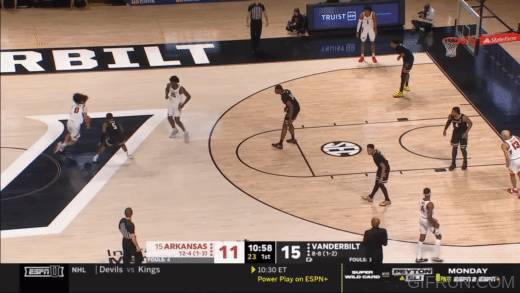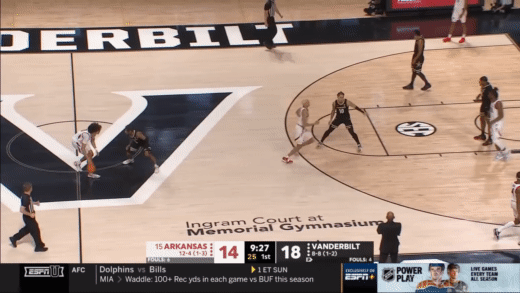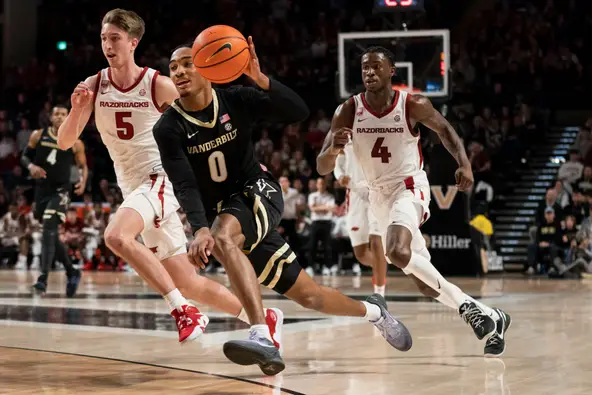After offensive struggles hurt the Hogs for several games, it was the defense that fell apart in Nashville during an ugly 97-84 loss to Vanderbilt. Arkansas is now 1-4 in SEC play. Even though the schedule is about to get much easier, the Hogs’ season is at risk of getting away from them.
The Hogs tried a new starting lineup, inserting Makhel Mitchell into the game for the second straight time, this time in place of Jordan Walsh (Makhel started for Ricky Council IV against Alabama). It was a total bust, and we’ll discuss why below.
Team Stats

The offense looked good, at least. The Hogs got nothing from transition (again) but had an excellent halfcourt game against a bad-but-not-terrible defense. The problem was that Vanderbilt just lit the Hogs up. It was entirely in halfcourt: as we expected, Vandy didn’t really try to run. It was all 3-pointers and free throws.

Yikes. Let’s talk about it:
- Arkansas at least shot well. That’s a good news. Vanderbilt mixed man and zone, as we expected, but the Hogs look prepared for both.
- Vanderbilt’s 3-point shooting carried the day. The Commodores killed the Hogs from beyond the arc. The Commodores ran tremendous halfcourt sets and Arkansas just couldn’t stay in front of them. I think there was so much focus on the Arkansas offense that defensive prep was overlooked.
- I’m not buying that Vanderbilt free throw rate. Take away the four technical fouls, and Vandy won the personal foul battle 30-16, even though Arkansas had more shots at the rim. That’s… not probable. That’s the nice way of saying it… “that’s BS” is probably more accurate. Jerry Stackhouse threw a fit and got the calls his team needed in the second half, when Arkansas was whistled for 19 personal fouls. Yes, there are tons of videos circulating on social media of Vanderbilt players shoving Hog players away from the ball with no call. There’s no point in revisiting it: it’s obviously crap.
- Vanderbilt’s 59% offensive rebound rate is a different issue. This is also crap… but it reflects poorly on the Hogs, not the officials. Arkansas knew Vanderbilt wanted to crash the offensive glass, so they started the Mitchell twins together instead of Jordan Walsh, who has been struggling on offense.
The “two Mitchells” plan did not work, as we see below.
Individual Stats

Makhel had just two rebounds in 18 minutes, while the Hogs were -17 during Makhi’s 22 minutes. An all-around disaster that was. Apparently putting your two best defensive rebounders on the floor together isn’t a foolproof plan: putting two slower forwards together allowed Vanderbilt to space the Hogs on the perimeter and get better shots around the rim. I have no idea what the thinking was there, but hopefully we’ve seen the last of that this season.
The Hogs have tinkered with the starting five over the last two games, giving Makhel more minutes in both game after Jalen Graham got a big boost in minutes against Alabama. The Makhel move didn’t work in either game, while the Graham move only kind of worked. That’s because in both cases, a guy who needed to be on the floor was on the bench…
Jordan Walsh is Arkansas’ offensive MVP for the season
One of the big lineup changes for the Vanderbilt game was to bring freshman Jordan Walsh off the bench in a reduced role. Walsh has been a starter all season but has struggled on offense since the start of SEC play. Walsh played just 17 minutes against the Commodores, his fewest since the UNC Greensboro game.
A reduced role for Walsh makes sense, right? After all, the general consensus around Walsh is that while his individual defense is excellent, he’s been very bad on offense, so he’s not helping the team. There are three claims made in that sentence… and all of them are false.
Claim 1: His individual defense is excellent. Not exactly. We can use Defense RAPM (DRAPM), which is the gold standard of evaluating defensive skill, as it measures how good the team’s defense is while a player is on the floor, regardless of who he’s sharing the floor with. Walsh’s DRAPM is graded at 88, which is just fourth-best on the team, behind Black, Council, and Devo. He’s a fine defender, but certainly not elite.
A less-reliable but still interesting way to evaluate his defense is how many opposing possessions he forcefully ends. The stat here is “kills”… a kill is a block, steal, or drawn charge. Walsh averages 3.3 kills per 40 minutes, which ranks just 6th out of the 11 Hogs who have played at least 80 minutes this season. Even worse, Walsh’s kills come at a high cost: he averages just 0.69 kills per personal foul, which is quite bad. That’s 9th of 11, ahead of only Jalen Graham and Joseph Pinion. A high kill-to-foul ratio signifies a skilled defender who can make plays without fouling. Walsh can’t.
Claim 2: He’s been very bad on offense. Surely this claim is unimpeachable! Walsh was 0 of 6 from the floor against Vanderbilt. In SEC play, he’s 12 of 41 from the field, 1 of 17 from 3, and 2 of 4 from the line. Except, somehow it’s not. Walsh’s ORAPM is graded at… 100. That means, he’s among the best 1% of all Division I players on offense this season. It’s best on the team as well.
Figuring out why this is is more of a challenge. Walsh’s personal offensive rating of 101.0 is just 7th on the team. His EFG% of just 47% is pretty bad, as is his FT USG of 15%. So he’s creating very little value in terms of direct scoring. But then you see other numbers: his assist rate of 8% is pretty good, and significantly better than whoever replaces him at the 4. His turnover rate of 14% is third-lowest on the team, trailing only Nick Smith and Kamani Johnson. His offensive rebound rate of 6% isn’t amazing for a 6’7 guy, but it’s better than other perimeter players.
The “other perimeter players” is key here. Walsh enables Arkansas to space the floor with 4-out looks. Here are some team offensive efficiencies for some lineup combos featuring Arkansas’ top two scorers playing with Walsh versus playing without him:
- Council + Walsh: 100.0, Council no Walsh: 88.1, Difference -11.9
- Black + Walsh: 106.5, Black no Walsh: 88.7, Difference -17.8
Just so you know: those numbers are for SEC play only, when Walsh has supposedly been struggling and a major liability.
So how is Walsh doing this? Despite the fact that his shot is not falling, Walsh is moving around really well. He’s getting himself into great spots on the floor to help the offense.
Here’s an example. This is Walsh’s first field goal attempt against Vanderbilt:

So the shot is missed but rebounded by Council, who ended up hitting an and-one. How did Walsh help create that? Because he’s a perimeter player! At the beginning of the gif, watch him flash from the baseline up to the wing to receive the pass, drawing his man (6’6 Jordan Wright) to the perimeter with him. By the time the shot goes up, there’s nobody under the basket, so the long rebound is available.
Just a minute later, he does this (watch Walsh, not the ball):

Walsh did everything here. He screened Makhel Mitchell’s man, making the high pick-and-roll easy to set up. Then he removed the low help defender (6’7 Myles Stute) by exiting the lane in time for Black to come thundering downhill. That type of awareness for where he is on the floor and how his movement will impact the play is really impressive.
There is no statistical award for what Walsh did in these two plays. Officially, he was 0 of 1 from the field in those two possessions. But Arkansas as a team got a pair of and-ones and ended up with five points there, and Walsh was more responsible than anyone else.
When the Hogs replace Walsh, they’re putting in someone who they hope will impact the box score more directly, but it’s reducing the efficiency of Arkansas’ offense. This is the obvious issue with losing Trevon Brazile for the season. He provided that perimeter talent as well and could have done many of things that Walsh is doing, except with three more inches in height. But now Walsh is all the Hogs have. Consistently trying lineups that totally replace Walsh is not working.
Which leads us to the third claim.
Claim 3: He’s not helping the team. You’ve probably figured out that this isn’t true. Walsh is second on the team in RAPM, only slightly behind Black. That means that Arkansas’ plus-minus is second-best with Walsh on the floor even when we account for who else Walsh shares the floor with. Independent of the other nine guys on the floor, he’s second-best at improving the team margin. Despite a rough start to SEC play, his numbers haven’t budged in that department.
After all, despite going 0 of 6 from the floor and racking up four fouls, Arkansas was +9 in Walsh’s 17 minutes against Vanderbilt. The Hogs outscored the Commodores 45-36 during the 28 possessions that Walsh was on the floor. Over the other 42 possessions and 23 minutes, Arkansas was outscored 51-29. It’s been that way all season long.
So who plays the 5?
If Arkansas commits to this 4-guard strategy with Walsh at the 4 – which they should! – that leaves the question of who should play the 5. It’s been Makhi Mitchell all season, but Makhi has been struggling. He entered SEC play with a DRAPM of 76, and it’s now down to 62. That’s a sizable defensive regression in just five games.
So who should be getting those minutes? It’s a four-man race.
Makhel Mitchell. Makhi’s brother is the tallest Hog in the rotation at 6’10. His DRAPM of 71 is now better than his brother. He also leads the team in DBPM, defensive rating, and block rate. Offensively, he turns it over too often (21%) which is why his offensive numbers aren’t great: just 46 ORAPM.
Makhi Mitchell. Makhi has played the most minutes at the position even as his defense has struggled against the big boys. He’s still sporting a 117.8 offensive rating, which is the best of all Arkansas forwards. He shoots 65% and rarely turns it over (just 15%). Still, that DRAPM of 62 is bad. It’s actually the worst of any Hog.
Jalen Graham. If you need a high-volume option, Graham is your man. His 33% USG is the highest on the team. However, he grades as the worst player on the team in RAPM (43) and ORAPM (24). His defense is only slightly better than Makhi’s, and he’s much more foul-prone. If he can get into a scoring rhythm, he’s dangerous; otherwise, he’s a liability.
Kamani Johnson. Finally we come to Kamani, who manages to lead all four centers in RAPM (93), ORAPM (91), and DRAPM (83). Yes, he grades as Arkansas’ best option on offense and defense at center. Offensively, he has the lowest turnover rate of all currently-healthy Hogs (12%) and leads the team in offensive rebound rate (17%) and free throw USG (32%). So he can crash the boards and draw fouls. Defensively, he leads the team in steal rate (4%). His 10% USG is incredibly low, but he still finds ways to make a positive impact.
If Kamani replaced Makhi in the starting lineup, the Hogs would be putting their best five players (by RAPM) on the floor at once: Black, Devo, Council, Walsh, and Kamani.
That exact lineup has played exactly 50 possessions this season. Here’s how they went:
- North Dakota State +1
- Oklahoma +5
- Bradley +6
- LSU +2
- Missouri -1
- Auburn +1
- Vanderbilt 0
- Total: +14
That’s an offensive efficiency of 124.0 and a defensive efficiency of 97.9, with the vast majority of those possessions coming against power conference opponents. Over a 70-possession game, that’s an 87-68 victory. Maybe I would consider using this lineup more often?
Up Next
There’s no time to lick wounds with a trip to Missouri on the docket. The Hogs are going to have to start figuring this thing out soon.
Thanks for reading! Be sure to follow us on Twitter and on Facebook.
The latest from Fayette Villains, straight to your inbox
Enter your email to subscribe and receive new post alerts and other updates. You can unsubscribe at any time.
